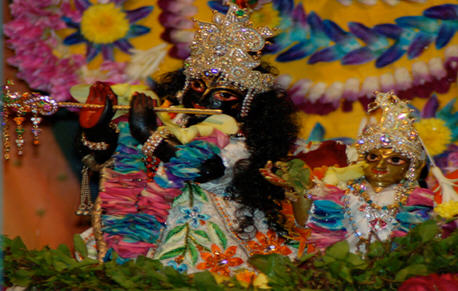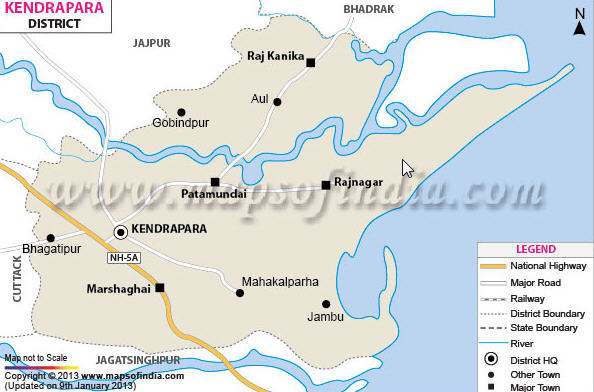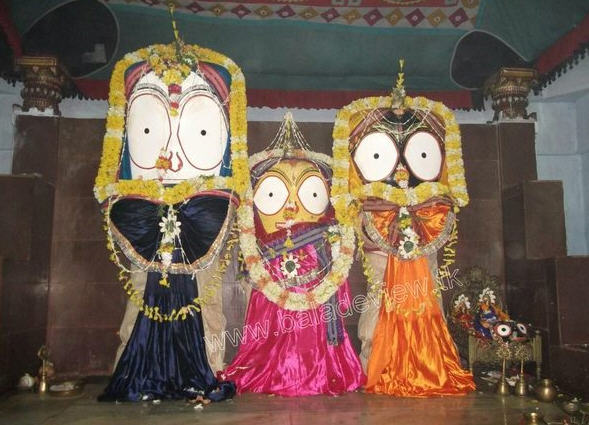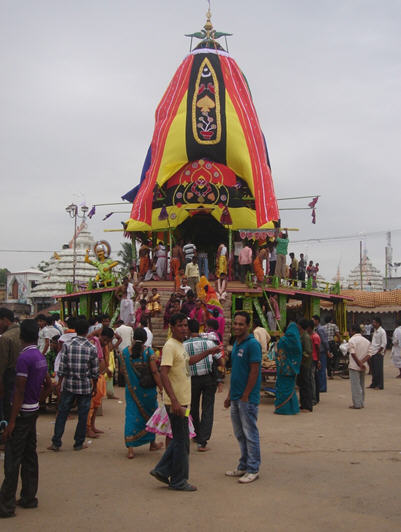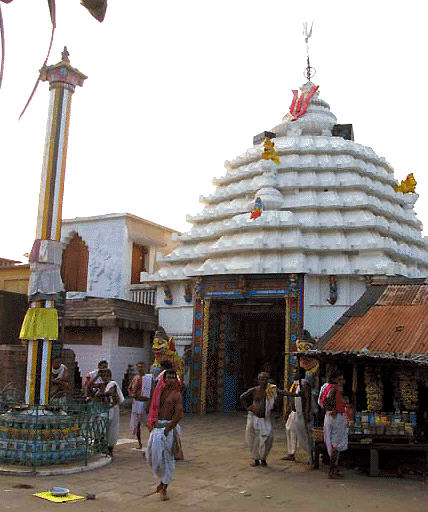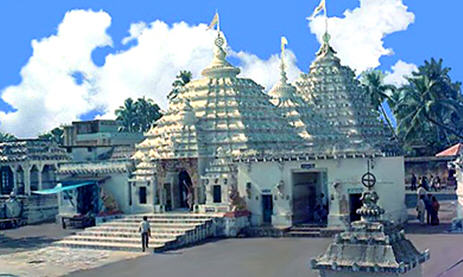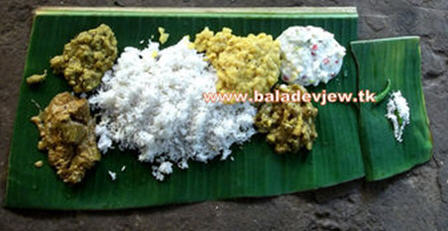By Satyaraja Dasa Maharaja Prataparudra, a king who played a central role in Sri Chaitanya Mahaprabhu’s life, is mentioned in all of Lord Chaitanya’s sacred biographies as well as in secular historical records. For example, Prabhat Mukherjee, a scholar of Orissan history, has written several books on the Chaitanya tradition, touching on Maharaja Prataparudra’s genealogy and political career. Such historical accounts tell us that the wise king Purushottam Deva ruled Orissa until 1497, when he was succeeded by Prataparudra, who ruled until 1540, about seven years after Sri Chaitanya Mahaprabhu returned to His eternal abode. Following the tradition of kings in his line, Prataparudra accepted the titles Gajapati and Gaudeshwar. His empire extended from the Ganges in Bengal to Karnataka, with his capital city in Cuttack, Orissa.
Though his capital was in Cuttack, like Gajapati kings before him he is also associated with Puri, the holy city in Orissa on the Bay of Bengal. Puri is the home of the Jagannatha temple and has been a pilgrimage site for centuries
Historical documents tell of Prataparudra’s battles with both Hussein Shah, the ruler of Bengal, and King Krishnadeva Raya of Vijayanagar, a South Indian kingdom. Hussein Shah played a role in the history of Chaitanya Mahaprabhu: Rupa Gosvami and Sanatana Gosvami, leading disciples of Lord Chaitanya, were ministers in the Shah’s government before retiring to join Lord Chaitanya’s mission.
Despite recurring battles during his rule, King Prataparudra led a disciplined and religious life. This is evident from the following account, given to the Vijayanagar emperor by a spy in his court:
[The Gajapati king] gets up from bed early in the morning two hours before sunrise and salutes two Brahmins before looking at any other person. Then accompanied by the Sixteen Patras [the Brahminical council], he goes on a ride of about twenty or thirty miles before returning to the palace. After taking his bath, he engages himself in the daily worship of Lord Jagannath, after which he takes his midday meal. After food, he recites the Ramayana. Then, putting on official robes bedecked with jewels, he sits in the court and transacts his daily business.
—From Dr. R. Subrahmanyam, The Suryavamsi Gajapatis of Orissa
A book called Sarasvati-vilasa, accepted as authoritative by Orissan historians, says that King Prataparudra had four queens, named Padma, Padmalaya, Ila, and Mahila. It is also written that by the time of his death, Prataparudra had thirty-two sons and several daughters. Among his many children, Sarasvati-vilasa highlights the life of one son, Purushottam. Chaitanya-charitamrita (Antya 3.9.99) and Bhakti-ratnakara (6.65) also speak of Purushottam, confirming information from secular texts.
Documents of the Jagannatha temple inform us that even before meeting Sri Chaitanya Mahaprabhu, Prataparudra followed the custom of sweeping the road before Lord Jagannatha’s chariot. They also tell us that he was well educated and a patron of learning and brahminical culture. He had already acquired knowledge of the Srimad-Bhagavatam and discussed truths about Krishna with Ramananda Raya, one of Chaitanya Mahaprabhu’s most important associates and the governor, under the king, of Rajamahendri in the south.
Ramananda Raya dedicates the prefatory verse of every song in his devotional play Jagannatha-Vallabha-Natakam to King Prataparudra, indicating the extent of the king’s attraction for hearing the pastimes of Radha and Krishna. The king’s soft, devotional heart is perhaps most clearly evident in the story behind a painting he commissioned. After many of the Lord’s intimate associates had passed on, the king wanted to “immortalize” them for the pleasure of the remaining Vaishnavas, particularly for Srinivasa, a greatly respected second-generation devotee of Sri Chaitanya Mahaprabhu. As the story goes, when Srinivasa arrived in Puri he hoped to study the Bhagavatam under Gadadhara Pandita. But Gadadhara’s manuscript had been irreparably damaged by his tears of spiritual ecstasy. So he sent Srinivasa back to Bengal to get another copy. But by the time he returned, Gadadhara had passed away, leaving Srinivasa disconsolate. To assuage Srinivasa’s grief, Maharaja Prataparudra gave him the painting, so that he could regularly meditate on the Lord and His devotees. The grandson of Srinivasa later gave it to a devotee named Nanda Kumar, which is how it arrived in Kunja-ghat, Kumar’s ancestral home.
The authenticity of this painting has come into question. Did King Prataparudra actually commissioned it? This doubt has been exacerbated by the fact that there are several modern renditions of the original work, all with variations. Gopal Gosh, of the Vrindavan Research Institute (UP, India)—where such things are thoroughly analyzed and catalogued—states after extensive study, “There is no doubt about the authenticity of the painting.” Still, not everyone agrees. But it is certain that the painting has been part of the tradition for several centurie
s. 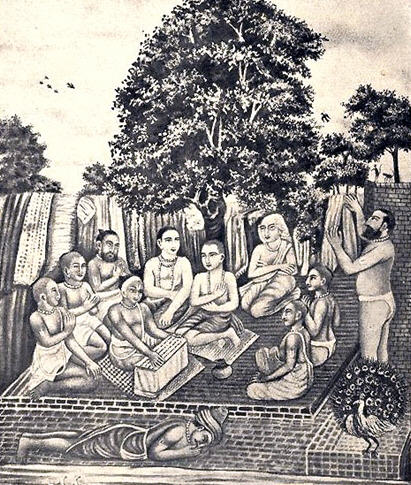
( Illustration from "Chaitanya's Life and Teachings by Jadunath Sarkar, Calcutta, 1922. The painting depicts King Prataparudra offering obeisances to Lord Chaitanya, who is sitting with Advaita Acharya, Nityananda Prabhu, Srivasa Acarya, Rupa and Sanatana Goswamis, Gadadhara (reading Bhagavad-gita), and Haridasa Thakur (standing). This image is found in the Chaitanya's Life and Teachings manuscript by J. Sarkar, and as the caption states, the painting was in the possession of the Zamindar of Kunjaghata. Raja Prataparudra of Puri ordered this likeness of Sri Chaitanya to be painted in watercolours, with the King himself depicted lying prostrate before his great spiritual teacher.)
Though there is compelling historical evidence for Pratapuradra’s existence and his reign in sixteenth-century India, as we have seen, his importance as a monarch is overshadowed by his spiritual significance in the pastimes of Lord Chaitanya. The book Gaura-ganoddesha-dipika, by Kavi Karnapura, is accepted by spiritual masters in Lord Chaitanya’s line as the authority on identifying the associates of Lord Chaitanya. In Gaura-ganoddesha-dipika (118) the author writes, “Maharaja Prataparudra, who was as powerful as Lord Indra, had formerly been Maharaja Indradyumna, who began the worship of Lord Jagannatha.” It is no wonder, therefore, that as Prataparudra this soul is intimately connected to Jagannatha yet again, but this time through the grace of Sri Chaitanya Mahaprabhu.
On a Quest to Meet the Lord The blessings that Chaitanya Mahaprabhu showered on King Prataparudra have been documented in most of Lord Chaitanya’s biographies: Murari Gupta’s Kadaca, Vrindavana Dasa Thakura’s Chaitanya-Bhagavata, Kavi Karnapura’s Chaitanya-charitamrita-maha-kavya and Chaitanya-candrodaya-nataka, Locana Dasa’s Chaitanya-mangala, and Krishnadasa Kaviraja Gosvami’s Chaitanya-charitamrita. They tell essentially the same story:
King Prataparudra, though a monarch, was a great devotee of Lord Krishna. Naturally, when Chaitanya Mahaprabhu, Krishna Himself, came to Puri, the king wanted to see Him. But Mahaprabhu told His associates, “I cannot give him what he wants. Because he is a king, he is like a black serpent.” Chaitanya Mahaprabhu then made His position clearer. “For a renunciant like Me,” He said, “it is risky to associate with two kinds of people: women, and persons involved in worldly matters.
” 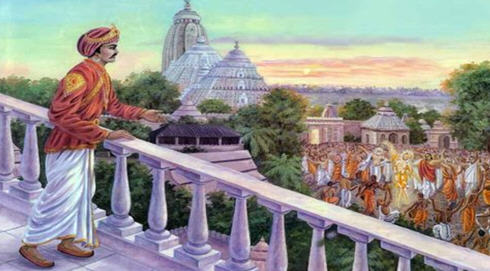
Although this particular king was a very advanced devotee, Mahaprabhu, on principle, still denied him His association. Lord Chaitanya was very strict, setting an example for others who would take up the life of renunciation. When Nityananda Prabhu, Advaita Acharya, Ramananda Raya, and Sarvabhauma Bhattacharya—all beloved associates of Lord Chaitanya—requested Him to see the king, He told them, “I’ll leave Puri and going to Alalanatha, or somewhere else. I will not remain here. You can remain here with him. But I will not.” This is how strongly He felt about avoiding the association of men involved in money and power.
Disappointed, Prataparudra was ready to renounce the world himself. If Lord Chaitanya would not see him because of his royal position, then why not give it up? Sarvabhauma Bhattacharya, Ramananda Raya, and the others told Lord Chaitanya of the king’s determination, and Lord Chaitanya was pleased. Still, He stood by His vow of renunciation and again asserted that He would avoid the king, despite the king’s devotion.
Nityananda Prabhu then suggested that Lord Chaitanya, out of His mercy, send the king a piece of His outer garment to appease him. Lord Chaitanya did so, and Prataparudra worshiped that garment as if it were Lord Chaitanya Himself.
Ultimately, the great devotee Ramananda Raya interceded on the king’s behalf, and by his prodding, Lord Chaitanya agreed to see the king’s son. After all, Lord Chaitanya reasoned, “a son is one’s own self born again,” as the saying goes. And the young prince was naturally not as ensconced in worldly matters as his father. So Lord Chaitanya’s associates brought the boy to Him.
The prince was dark-hued and handsome, reminding Lord Chaitanya of Krishna Himself. Lord Chaitanya showed him special mercy. Upon seeing the boy, Mahaprabhu embraced him, and the young prince swooned in ecstatic love for Krishna. Later, he went to his father, Prataparudra, who naturally embraced his son as well and received that same intense love.
Sarvabhauma’s Plan
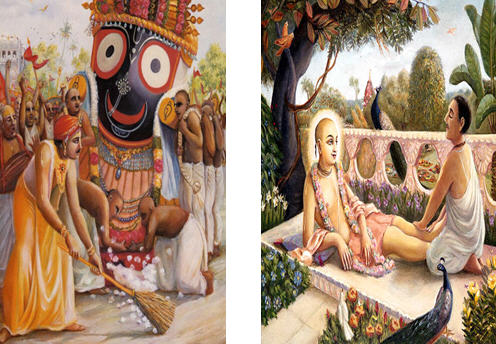
Feeling Lord Chaitanya’s ecstatic love for Krishna, the king now wanted to be in Mahaprabhu’s presence more than ever. Sarvabhauma then devised a plan: The Rathayatra festival would soon be held in Puri, and in spiritual bliss Mahaprabhu would no doubt dance like a madman before the cart of Lord Jagannatha. After a while, Lord Chaitanya would want to rest and would retire to a nearby garden. At that point, the king could, in the dress of a commoner, approach Lord Chaitanya while reciting intimate passages from the Tenth Canto of Srimad-Bhagavatam. These sweet verses never failed to move Lord Chaitanya into ecstatic trance. Mahaprabhu would then embrace the king under the assumption that he was a simple Vaishnava.
The day of the festival finally came, and it was marked by the king’s humble act of sweeping the road before Lord Jagannatha. When Mahaprabhu saw this, He was inclined to the king more than ever, and He bore this in mind as He ecstatically sang and danced before the majestic cart. At one point, His mystic reverie reaching a crescendo, He nearly pass out. By His divine arrangement He allowed Prataparudra to be right at His side to catch Him in his arms. The touch of the king, however, restored Mahaprabhu to His senses, and He chided Himself for having touched a worldly person. The Chaitanya-charitamrita tells us something deeper: Lord Chaitanya inwardly relished His association with the king but needed to set an example for others in the renounced order of life.
Sarvabhauma’s plan, too, was enacted later on in the festival, and the king indeed received the embrace of Lord Chaitanya.
It is said that Prataparudra turned over the kingdom to his son even while Sri Chaitanya Mahaprabhu was present in this world. Soon after Lord Chaitanya’s passing, he was so grief-stricken that he left Puri. According to Bhakti-ratnakara (3.217-221), “When the king heard that Lord Chaitanya had departed, he fell to the ground and lamented. Hitting his head again and again, he fell unconscious, and only the company of Ramananda Raya kept him alive. The king was unable to bear the absence of Lord Chaitanya, and so he left Puri, staying elsewhere for the rest of his days.”
Historian N. N. Vasu writes in his Archeological Report of Mayurbhanj that Maharaja Prataparudra started for Vrindavana but didn’t make it there. While en route, he passed away in the village of Ramachandrapur in the Mayurbhanj district of Orissa about eleven miles south of the district capital, Baripada. The name of the village was then changed to Pratappur in his honor, and it is known by that name today.
There is a temple in this town with Chaitanya Mahaprabhu, Jagannath and Dadhivaman deities. The priests of this temple say that when Mahaprabhu left Puri for Vrindavan, Prataparudra had a wooden murti of the Lord made. When Mahaprabhu disappeared, the King decided to retire to Vrindavan. He left with this Chaitanya deity, but when he arrived at Ramachandrapur, he fell ill and could not proceed. Knowing that his death was near, he made land endowments and engaged 54 Brahmin priests for the deities’ continued service. From this time onward, the town was known as Pratapapur. The king of Mayurbhanj than built a temple in Pratapapur which got desecrated due to foreign invasion . are now being worshipped in a small hut. A building reputed to be Maharaja Prataparudra’s samadhi stood near the Pratapapur Dak Bungalow, but it slipped into the river during a flood. Even so, many pilgrims still come to Pratapapur to worship the deity of Mahaprabhu on the his appearance day in the month of Phalgun (March).
